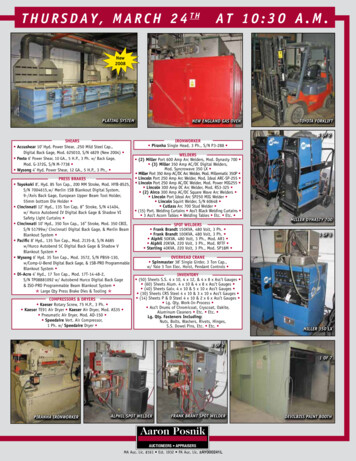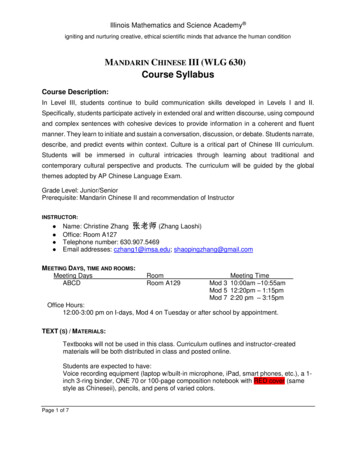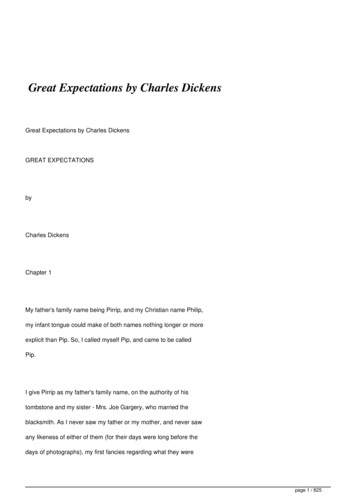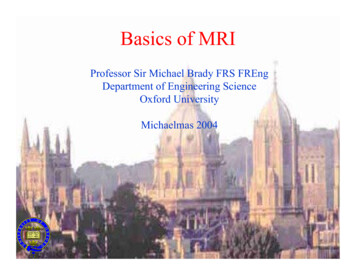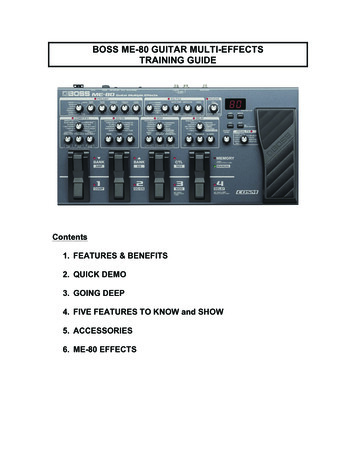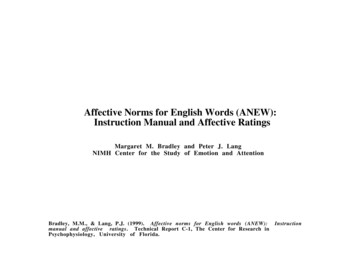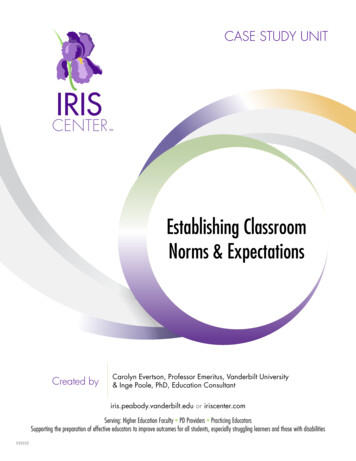
Transcription
CASE STUDY UNITEstablishing ClassroomNorms & ExpectationsCreated byCarolyn Evertson, Professor Emeritus, Vanderbilt University& Inge Poole, PhD, Education Consultantiris.peabody.vanderbilt.edu or iriscenter.comServing: Higher Education Faculty PD Providers Practicing EducatorsSupporting the preparation of effective educators to improve outcomes for all students, especially struggling learners and those with disabilities032522
TABLE OF CONTENTSEstablishing Classroom Norms & ExpectationsContents:PageCredits. . . . . . . . . . . . . . . . . . . . . . . . . . . . . . . . . . . . . . . . . . . . . . . . . . . . . . . . . . . iiStandards. . . . . . . . . . . . . . . . . . . . . . . . . . . . . . . . . . . . . . . . . . . . . . . . . . . . . . . . . iiiIntroduction . . . . . . . . . . . . . . . . . . . . . . . . . . . . . . . . . . . . . . . . . . . . . . . . . . . . . . . ivSTAR SheetsStating Expectations Clearly . . . . . . . . . . . . . . . . . . . . . . . . . . . . . . . . . . . . . . . . 1Implementing Classroom Rules and Procedures . . . . . . . . . . . . . . . . . . . . . . . . . . . 3Supporting Expectations Consistently . . . . . . . . . . . . . . . . . . . . . . . . . . . . . . . . . . 7Reevaluating Established Norms . . . . . . . . . . . . . . . . . . . . . . . . . . . . . . . . . . . . . 9Case StudiesLevel A, Case 1. . . . . . . . . . . . . . . . . . . . . . . . . . . . . . . . . . . . . . . . . . . . . . . . 10Level A, Case 2. . . . . . . . . . . . . . . . . . . . . . . . . . . . . . . . . . . . . . . . . . . . . . . . 12Level B, Case 1 . . . . . . . . . . . . . . . . . . . . . . . . . . . . . . . . . . . . . . . . . . . . . . . . 13Level C, Case 1. . . . . . . . . . . . . . . . . . . . . . . . . . . . . . . . . . . . . . . . . . . . . . . . 15Answer Key . . . . . . . . . . . . . . . . . . . . . . . . . . . . . . . . . . . . . . . . . . . . . . . . . . . . . . 18* For an Answer Key to this case study, please email your full name, title, and institutionalaffiliation to the IRIS Center at iris@vanderbilt.edu.iris.peabody.vanderbilt.eduThe contents of this resource were developed under a grant fromthe U.S. Department of Education, #H325E120002. However,those contents do not necessarily represent the policy of the U.S.Department of Education, and you should not assume endorsement by the Federal Government. Project Officer, Sarah Alleni
CREDITSEstablishing Classroom Norms & ExpectationsTo Cite ThisCase Study UnitEvertson, C., Poole, I., & the IRIS Center. (2003). Establishingclassroom norms and expectations. Retrieved from oads/pdf case studies/ics norms.pdfContentContributorsCarolyn EvertsonInge Poole2003Case StudyDevelopersKim SkowErik DuntonGraphicsiris.peabody.vanderbilt.edupp. 3, 6 Rules Boxes Adapted from Evertson & Harris, 2003;Evertson, Emmer, & Worsham, 2003iiii
STANDARDSEstablishing Classroom Norms & ExpectationsLicensure and Content StandardsThis IRIS Case Study aligns with the following licensure and program standards and topic areas.Council for the Accreditation of Educator Preparation (CAEP)CAEP standards for the accreditation of educators are designed to improve the quality andeffectiveness not only of new instructional practitioners but also the evidence-base used to assess thosequalities in the classroom. Standard 1: Content and Pedagogical KnowledgeCouncil for Exceptional Children (CEC)CEC standards encompass a wide range of ethics, standards, and practices created to help guidethose who have taken on the crucial role of educating students with disabilities. Standard 2: Learning EnvironmentsInterstate Teacher Assessment and Support Consortium (InTASC)InTASC Model Core Teaching Standards are designed to help teachers of all grade levels and contentareas to prepare their students either for college or for employment following graduation. Standard 3: Learning EnvironmentsNational Council for Accreditation of Teacher Education (NCATE)NCATE standards are intended to serve as professional guidelines for educators. They also overviewthe “organizational structures, policies, and procedures” necessary to support them. Standard 1: Candidate Knowledge, Skills, and Professional DispositionsThe Division for Early Childhood Recommended Practices (DEC)The DEC Recommended Practices are designed to help improve the learning outcomes of youngchildren (birth through age five) who have or who are at-risk for developmental delays or disabilities. Topic 3: Environment Topic 5: Instructioniris.peabody.vanderbilt.eduiiiiii
INTRODUCTIONEstablishing Classroom Norms & ExpectationsThis case study set focuses on the establishment of classroom norms and expectations. Thisintroduction offers an overview of norms and expectations and how they are communicated andestablished in a classroom. To establish norms and expectations in a classroom is a complex, longterm task. Your skill in successfully undertaking it will evolve as you become more experienced. Thegoal of this case study set is to help you understand how to prevent many problem behaviors byputting supportive classroom structures in place as you set up an effective classroom.What is an effective classroom? It is one that runs smoothly, with minimal confusion and downtime, and maximizes student learning. An effective classroom has patterns and routines in placethat make interaction and movement within that classroom easy to organize and accomplish. Suchpatterns and routines are established through the development of classroom rules and procedures.Rules are the explicit statements of teacher’s expectations for students’ behavior in a classroom.Procedures are the patterns for accomplishing classroom tasks. Teachers communicate theirexpectations to students through the development and enactment of both.Expectations are desired behaviors or outcomes. Within a classroom, a teacher can make his or herexpectations known to students, or the teacher can cause students to guess at the expectations. It ismuch easier for students to meet a teacher’s expectations when they know what these expectationsare. Teachers can make their expectations known to students by directly teaching the classroomrules and procedures, providing opportunities for the students to practice them, and consistentlyresponding to students’ behavior. A teacher’s consistent responses can include both positiveconsequences to reinforce a student’s appropriate behavior and negative consequences to deter astudent’s inappropriate behavior.Students also have expectations for their own behavior. When the behavior that the teacher andstudents expect and exhibit becomes so routine that it seems to be in consensus, a classroom normfor that behavior has been established. Norms can be defined as accustomed ways of perceiving,believing, evaluating, and acting in an environment (Goodnough, 1971). In other words, norms arethe familiar ways we have of interacting with each other in a particular setting.iris.peabody.vanderbilt.eduiviv
Case Study Set DefinitionsNorms familiar ways of interacting in a classroomExpectations desired behaviors or outcomesRules written expectations for behavior in a classroomProcedures patterns for accomplishing classroom tasksWithin classrooms, a common norm for requesting a turn to speak during instruction is to raise one’shand and wait to be acknowledged. This classroom norm develops when a teacher teaches his orher students how to raise their hands when they want to speak, has students practice raising theirhands, and consistently responds to students’ behavior (positively when they raise their hands, andnegatively when they don’t). In fact, this norm often becomes so familiar it is used in other settings––have you ever raised your hand for a turn to speak at the dinner table?Whereas classroom norms, such as raising one’s hand, are sustained by consensus, they can alsobe suspended or changed if they are not supported or reinforced. For example, a norm for beingin class on time ceases to be a norm when there is no consequence for students’ tardiness. Thus,arriving late becomes the accepted practice. The actions and interactions that a teacher encouragesor allows to become familiar develop into that classroom’s norms. Therefore, thoughtful advanceplanning by the teacher can guide and establish effective group norms that support student learning.For example, prompt attendance promotes student learning by making certain that students areexposed to as much instructional time as possible. Therefore, a teacher might require promptattendance as well establish procedures to make prompt attendance a familiar routine. A classroomrule regarding prompt attendance might be stated as “Be in your seat and ready for class whenthe bell rings.” A procedure involved in preparing for class might require students to place theircompleted homework in a designated location as they enter the classroom. When all the proceduresof preparing for class prior to the bell’s ring become routine for students, prompt attendance hasbecome an established classroom norm.Ultimately, a teacher wants to establish classroom norms that create an effective classroom in whichstudent learning time is maximized. In this case study set, we will consider four specific aspects ofestablishing classroom norms and expectations:1. Stating expectations clearly,2. Implementing classroom rules and procedures,3. Supporting expectations consistently, and4. Reevaluating established norms.What the Research and Resources Say Teachers who establish and maintain norms for an effective learning environment spend moretime teaching because less time is usurped by discipline (Brophy, 2000). Norms that engender a supportive learning environment include acting and interactingresponsibly, treating others with respect and concern, and fostering a learning orientation(Brophy 1998; 2000; Good & Brophy, 2000; Sergiovanni, 1994). Effective school-wide norms can be established through a school-based program that focuseson supportive interactions among students (Solomon, Watson, Delucchi, Schaps, & Battistich,1988).iris.peabody.vanderbilt.eduvv
Resources:Brophy, J. E. (1998). Motivating students to learn. Boston: McGraw-HillBrophy, J. E. (2000). Teaching. Geneva, Switzerland: International Bureau of Education.Good, T. L., & Brophy, J. E. (2000). Looking in classrooms (8th ed.). New York: Longman.Goodnough, W. (1971). Culture, language, and society. Reading, MA: Addison-Wesley.Sergiovanni, T. (1994). Building community in schools. San Francisco: Jossey-Bass.Solomon, D., Watson, M. S., Delucchi, K. L., Schaps, E., & Battistich, V. (1988). Enhancingchildren’s prosocial behavior in the classroom. American Educational Research Journal, 25(4),527–554. What a STAR Sheet is A STAR (STrategies And Resources) Sheet provides you with a description of a wellresearched strategy that can help you solve the case studies in this unit.iris.peabody.vanderbilt.eduvivi
STAR SHEETEstablishing Classroom Norms & ExpectationsStating Expectations ClearlyAbout the StrategyExpectations are desired behaviors and outcomes. Teachers’ expectations of students are directlyconnected to students’ achievement of those expectations. The strategy of stating expectationsclearly involves the explicit acknowledgment of expectations for student actions and interactions inways that the students can understand and achieve.What the Research and Resources Say Students both want and need teachers to demonstrate authority by setting realistic academicand behavioral expectations (Brophy, 1998). Successful classroom managers help students identify what is expected of them and how toachieve these expectations (Brophy, 1998; Evertson, Emmer, & Worsham, 2003; Evertson &Harris, 1992). When teachers hold high expectations of students, the students typically meet higher standardsof performance (Good & Brophy, 2000). Low expectations are communicated to students when teachers provide less wait time, fewer orinappropriate reinforcements, less feedback, fewer opportunities to participate in instruction,reduced eye-contact, more criticism for failure, or by teachers showing less acceptance of thestudent’s ideas (Brophy, 1998; Good & Brophy, 2000). The expectations teachers have for students affect their current performance, and can influencefuture performance, particularly at the early grades (Wong, 1998). Clarity in instruction increases student academic engagement and achievement (Evertson &Emmer, 1982). Clarity in instruction includes actions such as framing the lesson in context, stating keycomponents of the content, linking these components together, focusing student attention onimportant elements, and providing examples (Snyder, Landt, Roberts, Smith, & Voskuil, 1993). In order to clarify expectations during all stages of a lesson, teachers can use advanceorganizers to set up instruction, provide guidance and feedback to students during instruction,and reflect with students after instruction (Brophy, 1998).Strategies to Implement Know what you want students to do and at what level of achievement. Make sure it issomething they can accomplish. In understandable increments, state what the task is, why you are asking students to completeit, the steps involved, and how the task will be assessed. Provide written directions if possible.Model the action(s) requested. Monitor student progress and offer feedback to students en route and following task completion.iris.peabody.vanderbilt.edu11
STAR SHEETEstablishing Classroom Norms & ExpectationsStating Expectations ClearlyResourcesBrophy, J. E. (1998). Motivating students to learn. Boston: McGraw-Hill.Evertson, C. M., & Emmer, E. T. (1982). Effective management at the beginning of the school yearin junior high classes. Journal of Educational Psychology, 74, 485–498.Evertson, C. M., Emmer, E. T., & Worsham, M. E. (2003). Classroom management for elementaryteachers (6th ed.). New York: Allyn & Bacon.Evertson, C., & Harris, A. (1992). What we know about managing classrooms. EducationalLeadership, 49, 74–78.Good, T. L., & Brophy, J. E. (2000). Looking in classrooms (8th ed.). New York: Longman.Johnson, T. C., Stoner, G., & Green, S. K. (1996). Demonstrating the experimenting society modelwith classwide behavior management interventions. School Psychology Review, 25(2), 199–214.Snyder, S. J., Landt, A., Roberts, J., Smith, J. S., & Voskuil, K. (1993, April). Instructional clarity:The role of liking and focusing moves on student achievement, motivation and satisfaction.Paper presented at the Annual Meeting of the American Educational Research Association,Atlanta. ERIC Document Reproduction Service ED 362 507.Wong, H. K., & Wong, R. T. (1998). The first days of school. Mountain View, CA: Harry K. WongPublications, Inc.iris.peabody.vanderbilt.edu22
STAR SHEETEstablishing Classroom Norms and ExpectationsImplementing Classroom Rules and ProceduresAbout the StrategyClassroom rules are a teacher’s stated expectations for student behavior. Classroom procedures arepatterns for accomplishing classroom tasks. Classroom rules and procedures are connected in threeways. First, rules are the expectation boundaries within which procedures are followed. Second,procedures form routines that help students to meet the expectations stated in the rules. Third, bothrules and procedures must be taught, practiced, and consistently supported to be effective in theclassroom. (Cohesive sets of rules and procedures are two aspects of a comprehensive behaviormanagement system.)What the Research and Resources Say A dependable system of rules and procedures provides structure for students. This structure helpsstudents to be engaged with instructional tasks and communicates to students that the teachercares for them. (Brophy, 1998). Authoritative implementation of rules includes communicating care and respect for students,teaching students what is expected of them and why this is of value, and responding tostudents’ actions and interactions in ways that help them to become more responsible selfregulated learners (Brophy, 1998). Rules are few in number, always apply, and must be understood by all. Procedures are many innumber, are specific to certain tasks, and must be understood by all. (Evertson & Harris, 2003) Teaching rules and procedures to students at the beginning of the year and enforcing themconsistently across time increases student academic achievement and task engagement(Evertson, 1985; 1989; Evertson & Emmer, 1982; Evertson, Emmer, Sanford, & Clements,1983; Johnson, Stoner, & Green, 1996). Effective teaching includes teaching functional routines (procedures) to students at the beginningof the year and using these routines to efficiently move through the school day (Leinhardt,Weidman, & Hammond, 1987). Having all students––including those with behavioral difficulties––participate in developingclassroom rules offers them the opportunity to cooperate, collaborate, and make connectionswith each other as well as to develop a sense of ownership in the classroom (Castle & Rogers,1993; Martin & Hayes, 1998). Sample Classroom Rules1. Respect yourself, your peers, and their property.2. Talk at appropriate times and use appropriate voices.3. Be in your seat and ready for class when the bell rings.4. Follow my directions.5. Obey all school rules.Adapted from Evertson & Harris, 2003;Evertson, Emmer, & Worsham, 2003iris.peabody.vanderbilt.edu33
Example Rules and ProceduresThe chart below connects sample classroom rules with some examples of procedures that helpstudents meet the expectation(s) within the stated rule.RuleSample Corresponding Procedure(s)Respect yourself, yourpeers, and their property.Be in your seat and readyfor class when the bellrings.Get permission to talk.Ask and receive permission before borrowing something.Place your completed homework in the homework basket asyou enter class.1. Raise your hand to request a turn when the teacher istalking.2. Use indoor voices during a class discussion, waiting for apause in the conversation to insert your thought.Strategies to Implement Anticipate what students need to know and do in the classroom, both academically andsocially, before the school year begins. Plan for the first days of school based on these learninggoals. For example, if students’ prompt attendance is needed to maximize instructional time,then plan for corresponding classroom rules and procedures by responding to such questionsas:– What time will class begin?– How will I be prepared to begin class promptly?– How will I present my expectations of promptness to students?– What consequences will result from tardiness? Select rules and procedures that you are able to sustain and state them positively (e.g., “Walkin the hallways” rather than “Don’t run”). See Guidelines for Writing Rules at the end of thisSTAR Sheet. Begin modeling and discussing the class rules and procedures on the first day of school. Explain to students the purpose and rationale for classroom rules and procedures. Identify positive examples of class rules and procedures in action and provide role-playopportunities for each. Develop, teach, practice, and support new procedures as necessary to support effectiveroutines in the classroom. Consistently respond to student behavior regarding the established classroom rules andprocedures.Keep in Mind Your rules (developed with your students or on your own) should support your learning goalsfor the class, should be ones your students can understand and accomplish, and should beassociated with clear positive and negative consequences. These rules may vary by subjectmatter, grade level, and group dynamics.iris.peabody.vanderbilt.edu44
Writing rules with your students is a lengthy process (2–3 mornings/ class sessions). The procedures you establish in your classroom should help students to comply with your statedexpectations, should be ones your students can understand and accomplish, and should beretaught as needed to help students remember the patterns. Your actions and interactions with students can either support or undermine the classroom rulesand procedures you are implementing. For example, if a teacher uses humiliation or sarcasm tocommunicate with students, the students are significantly less likely to feel respected and to offerrespect to others in turn.ResourcesCastle, K., & Rogers, K. (1993). Rule-creating in a constructivist classroom community. ChildhoodEducation, 70(2), 77–80.Evertson, C. M. (1985). Training teachers in classroom management: An experiment in secondaryclassrooms. Journal of Educational Research, 79, 51–58.Evertson, C. M. (1989). Improving elementary classroom management: A school-based trainingprogram for beginning the year. Journal of Educational Research, 83(2), 82–90.Evertson, C. M., & Emmer, E. T. (1982). Effective management at the beginning of the school yearin junior high classes. Journal of Educational Psychology, 74, 485–498.Evertson, C. M., Emmer, E. T., Sanford, J. P., & Clements, B. S. (1983). Improving classroommanagement: An experiment in elementary classrooms. The Elementary School Journal, 84,173–188.Evertson, C. M., & Harris, A. H. (2003). COMP: Creating conditions for learning. Nashville, TN:Vanderbilt University.Johnson, T. C., Stoner, G., & Green, S. K. (1996). Demonstrating the experimenting society modelwith classwide behavior management interventions. School Psychology Review, 25(2), 199–214.Leinhardt, G., Weidman, C., & Hammond, K. M. (1987). Introduction and integration of classroomroutines by expert teachers. Curriculum Inquiry, 17(2), 135–175.Martin, H., & Hayes, S. (1998). Overcoming obstacles: Approaches to dealing with problempupils. British Journal of Special Education, 25(3), 135–139.iris.peabody.vanderbilt.edu55
Guidelines for Writing Rules*(Accompanies Implementing Classroom Rules and Procedures STAR Sheet)Rules govern relationships––with others, time, space, and materials. They are consistentacross situations and few in number. The eight guidelines below can help you developeffective rules for your classroom.1. Consistent with school rulesClassroom rules should not conflict with school rules; school rules should be ineffect in the classroom.2. UnderstandableRules must be stated so that students clearly understand what is meant.Vocabulary should be consistent with students’ grade and ability level.3. DoableRules must be such that students are capable of following them. They must bewithin students maturation level and mental and physical abilities.4. ManageableRules should be easily monitored and not require excessive classroom time tohold students accountable.5. Always applicableRules should be consistent; they should not vary or change.6. Stated positivelyStating rules positively encourages the desired behavior. Although it is sometimesdifficult to state all rules positively, most “don’ts” can be transformed to “do’s.”(Even “No gum” can be stated as “Leave all gum at home.”)7. Stated behaviorallyRules are easily understood and monitored when defined with action statementsbeginning with a verb––statements that describe what students are to “do”––suchas “Leave all gum at home” or “Bring needed materials to class.”8. Consistent with your own philosophyYour rules should reflect what you believe about how students learn best.Used with permission. Evertson, C. M., & Harris, A. H. (2003). COMP: Creating Conditions for Learning (6th ed.). Nashville, TN: VanderbiltUniversity. p. 2.08E.*iris.peabody.vanderbilt.edu66
STAR SHEETEstablishing Classroom Norms and ExpectationsSupporting Expectations ConsistentlyAbout the StrategyThe consistent support of expectations is essential to the development of classroom norms thatpromote student learning. Consistency requires that the teacher equitably reinforces appropriatestudent behavior and deters inappropriate student behavior. Teachers must first teach students theclassroom rules and procedures, provide students practice with them, and then consistently respondto student actions and interactions in regard to these rules and procedures. (Teacher responses orconsequences are one component of a comprehensive behavior management system.)What the Research and Resources Say Teaching rules and procedures to students at the beginning of the year and enforcing themconsistently across time increases student academic achievement and task engagement(Evertson, 1985; 1989; Evertson & Emmer, 1982; Johnson, Stoner, & Green, 1996). Teachers should focus on increasing positive behavior and interactions by consistently enforcingexpectations (Shores, Gunter, & Jack, 1993). When teachers are inconsistent in their enforcement of expectations, students become uncertainof what those expectations are and whether the expectations apply to them (Evertson, Emmer,& Worsham, 2003). Three sources for inconsistency occur when a teacher exhibits:a. unreasonable expectations,b. incomplete monitoring, andc. halfhearted expectations (Evertson, Emmer, & Worsham, 2003). Students cannotaccomplish the unreasonable, try to get away with what they can, and know when abehavior is not really expected. Teachers who respond consistently feel positive about their teaching and help students improvetheir performance (Freiberg, Stein, & Huang, 1995). Clearly stating expectations and consistently supporting them lends credibility to a teacher’sauthority (Good & Brophy, 2000).Strategies to Implement Know and understand both your expectations for students and your responses when studentsmeet or do not meet these expectations. You should have responses for meeting yourexpectations (positive, or supporting, consequences) and for not meeting your expectations(negative, or deterring, consequences). State expectations clearly. Post your classroom rules. Practice the classroom procedures untilthey become routine. Monitor students’ progress in meeting expectations. Provide feedback to students as they work so they know if they are meeting your expectations.iris.peabody.vanderbilt.edu77
Indicate to students when they have or have not met your expectations. Respond to all studentswho meet or do not meet your expectations in an equitable manner consistent with your plans(as determined by first tip).Keep in Mind Supporting your expectations is not always easy or popular, but it is the best way to assure thatall students have equal opportunities to succeed. An adjective that might be used to describe ateacher who exhibits consistency is “fair.” Making exceptions for individuals to meet your expectations at a different level is sometimesnecessary (e.g., extenuating circumstances, IEP requirements, etc.), but may communicate toother students that the original expectation is not reasonable or meaningful. Be prudent aboutadjusting your expectations for individuals and be sure to communicate those adjustments andthe rationale for them to students.ResourcesEvertson, C. M. (1985). Training teachers in classroom management: An experiment in secondaryclassrooms. Journal of Educational Research, 79, 51–58.Evertson, C. M. (1989) Improving elementary classroom management: A school-based trainingprogram for beginning the year. Journal of Educational Research, 83(2), 82–90.Evertson, C. M. & Emmer, E. (1982). Effective management at the beginning of the school year injunior high classes. Journal of Educational Psychology, 74, 485–498.Evertson, C. M., Emmer, E. T., & Worsham, M. E. (2003). Classroom management for elementaryteachers (6th ed.). Boston: Allyn and Bacon.Freiberg, H., Stein, T., & Huang, S. (1995). Effects of a classroom management intervention onstudent achievement in inner-city elementary schools. Educational Research and Evaluation: AnInternational Journal on Theory and Practice, 1, 36–66.Good, T. L., & Brophy, J. E. (2000). Looking in classrooms (8th ed.). New York: Longman.Johnson, T. C., Stoner, G., & Green, S. K. (1996). Demonstrating the experimenting society modelwith classwide behavior management interventions. School Psychology Review, 25(2), 199–214.Shores, R. E., Gunter, P. L., & Jack, S. L. (1993). Classroom management strategies: Are theysetting events for coercion? Behavioral Disorders, 18(2), 92–102.iris.peabody.vanderbilt.edu88
STAR SHEETEstablishing Classroom Norms and ExpectationsReevaluating Established NormsAbout the StrategyReevaluating established norms is the practice of reflecting upon, and adjusting as necessary, theaccepted classroom norms. Since norms are developed and maintained through the interactionsof individuals, they can shift and change. The environments in which the norms are establishedcan also change. While reflecting upon the established classroom norms, a teacher comparesthe accepted norms of the classroom to those desired for maintaining an effective classroom.When a discrepancy is found between what is needed for a successful learning environment andthe established classroom norms, the teacher must adjust these norms through instruction, clearcommunication of expectations, and consistent support of these expectations. The process ofreevaluating established norms is one portion of a teacher’s continual evaluation of the learningenvironment in his or her classroom.What the Research and Resources Say As students become more familiar with classroom routines and procedures, additionalinstructional formats and more c
v iris .peabody .vanderbilt .edu v Case Study Set Definitions Norms familiar ways of interacting in a classroom Expectationsdesired behaviors or outcomes Rules written expectations for behavior in a classroom Procedures patterns for accomplishing classroom tasks Within classrooms, a common norm for requesting a turn to speak during instruction is to raise one's


